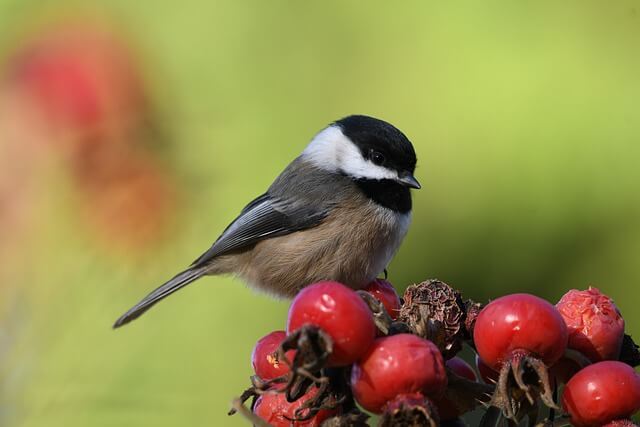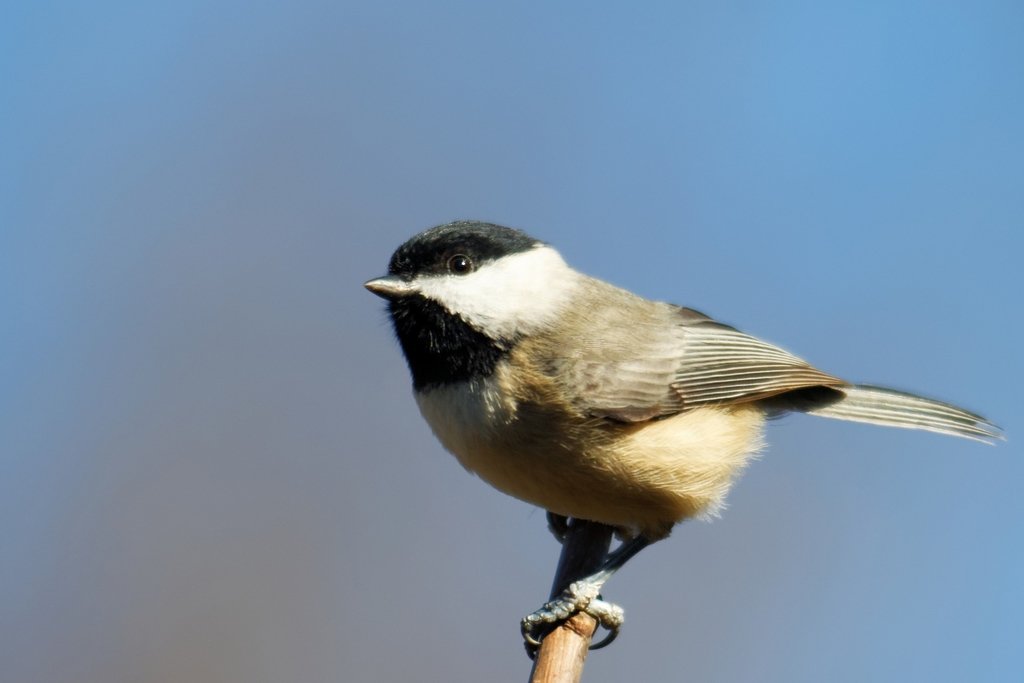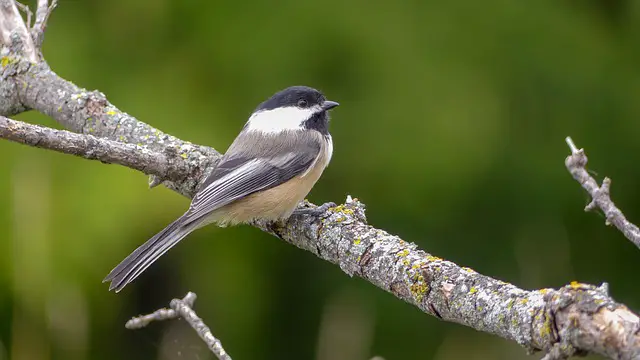
Welcome to a world where tiny birds with big personalities captivate our curiosity—the Black-capped Chickadee. Join me as we delve into the fascinating realm of Black-capped Chickadee facts, uncovering their charming behaviors, unique adaptations, and delightful quirks.
From their distinctive calls to their clever survival strategies, these feathered wonders have much to teach us about the wonders of nature. Let’s embark on a journey to explore and appreciate the secrets of the Black-capped Chickadee.
Table of Contents
- 1 Black-capped Chickadee Facts
- 1.1 Identification
- 1.2 Size
- 1.3 Distribution Range
- 1.4 Population
- 1.5 State bird of Massachusetts And Maine
- 1.6 Habitat
- 1.7 Food Sources
- 1.8 Behavior
- 1.9 Migratory Patterns
- 1.10 During the Winter Months
- 1.11 Predators
- 1.12 Average Lifespan
- 1.13 Nesting Habits
- 1.14 Songs
- 1.15 Attracting Chickadees to your Backyard
- 2 Frequently Asked Questions
- 3 Author
Black-capped Chickadee Facts
Identification
The Black-capped Chickadee is a small bird with a black cap and white cheek patches, black eyes, grayish-brown back, wings, and tail feathers with a white belly.
Size
- Length: 12–15 cm (4.5–6.0 in)
- Wingspan: 15–20 cm (6.3–8.3 in)
- Weight: 10–15 g (0.32–0.49 oz).
- Scientific Name: Poecile atricapillus
Distribution Range
The black-capped chickadee is a rather small, nonmigratory, non-boreal songbird that can be found in many parts of North America. It is found in the eastern and central United States, as well as the southeastern part of Canada.
These birds can be found year round throughout the northern United States and Canada; however, they are mainly concentrated around the east coast of North America during winter months.
Population
The population has been relatively stable for the past 20 years, with a total population of 41 million individuals. They inhabit both Canada and the USA, but occupy slightly different habitats in each country. Canada has a slightly higher population of about 21 million individuals, while the USA has about 19 million individuals.
The Canadian population is largely found in temperate and boreal forests, while the American population inhabits a variety of habitats including deciduous and coniferous forests, urban areas, agricultural land, and suburban gardens.
State bird of Massachusetts And Maine
It’s the state bird, and the national bird of Massachusetts, and Maine. It’s also the provincial bird of New Brunswick in Canada.
Habitat
Black-capped chickadees are the main inhabitants of coniferous forests, but they can also be found in deciduous and mixed forests. In winter, these birds live in the lower branches of trees, while in summer they are more commonly found high up in the canopy.
Food Sources
Chickadees have a varied diet that includes both seeds and insects, depending upon the availability of those in their area. They love to eat insects, berries, nuts, seeds, grubs, worms, insects, small frogs, and salamanders.
They will also eat almost any kind of plant food that you provide for them, including leaf litter, pellets, fruits, vegetables, grains, grasses, and nasturtium, although most commonly they eat leaf litter.
Behavior
Black-capped chickadees are interesting to watch because they display a range of behaviors that make them unique. Chickadees typically hop and glean insects from trees, but they can also hang upside down and even fly short distances.
Black-capped chickadees are among the most common birds in North America, and their varied behavior makes them an enjoyable bird to watch. They are active throughout the day, and their social interactions are entertaining to witness.
Migratory Patterns
The migration season for the black-capped chickadee usually lasts for between six and eight months, but can extend to more than ten months or longer if conditions are not right. Chickadees leave their wintering grounds in May through September and reach breeding areas in late March or early April.
Some birds are found in the southern part of the country, while others can be found in northern parts of the U.S., though the most common area of occurrence is in Maine.
Depending on where you look, you’ll find that the migration route is generally a long journey across open and wooded areas. They often fly southward along coastal waters to reach warmer climates, while others continue along the eastern seaboard, stopping along the way to feed and roost at night.
During the Winter Months
Most of the food the birds consume during the winter months comes from using up the fat reserves they have. They will eat a variety of different foods that are high in fat, such as seeds and nuts.
During these times, their body produces a great deal of fat, which provides them with a secondary source of energy.
The more fat they consume, the less energy they have to rely on, so it is crucial to have a supply of that fat for those days when they have to move to new locations.
Predators
The chickadees are very vulnerable to predation. They can be killed by raccoons, foxes, badgers, carrion birds, and even hawks, though these birds probably don’t carry diseases or parasites with them.
There are many types of predators that the black-capped chickadee has to worry about. One type of predator would be an owl. The other types of predator would be a foxes, badgers, hawks, raccoon or opossum which have long claws to grab the chicks from trees
Average Lifespan
The lifespan of the Black-capped Chickadee can range from three to six years, with females living longer than males. The lifespans of black-capped chickadees vary depending on gender and environment. Females live up to six years, while males typically only live for three years.
Nesting Habits
Chickadees have an instinct to build their nests under the eaves of houses and along fences and walls. Sometimes, they will choose an old building that contains a nesting box or some other hiding place such as a tree trunk.
Chickadee flocks tend to travel quite a distance during these long journeys. The average migration time is about seven hundred miles, although some birds make even longer journeys, like over one thousand miles. Their trip is known as a ‘migration’ only until they get to their nesting area.
Chickadees mate in January and February. The female lays one egg a day until there are about 5 to 10 eggs. The young chicks hatch in April and May. The chicks grow rapidly during their first year. At the end of the first year, the chickadee’s fledge and become independent.
In summer, they go on migration southward to overwinter on islands of the Atlantic or the Caribbean and to Central Africa and southern Asia. At the beginning of the second year, the birds fly south back to southern Canada and Alaska, with the female returning to the south.
Songs
The male chickadee is capable of singing with a high-pitched call, which is a mixture of a series of whistles and chirps. And they are vocal enough to attract a mate, especially females.

Attracting Chickadees to your Backyard
The black-capped chickadee is a small, stocky bird that loves to visit feeders for suet and sunflower seeds. With these 13 tips, you can attract this wonderful little creature into your backyard. The following products, below, have direct links to Amazon.
1) Planting bushes around the perimeter of your yard attracts many types of birds, including the black-capped chickadee. Some recommended plants are juniper, cedar trees, conifers, dogwoods, and lilac bushes.
2) To attract these beautiful birds to your backyard, it’s a good idea to get yourself a bird feeder like this squirrel-proof bird feeder. You can find the best deal on Amazon.
3) Black-capped chickadees will readily come to feeders with seed or suet cakes that have been hung from trees or posts.
4) Plant some Sunflowers throughout your yard.
5) Place feeders close to sheltering shrubs or trees where they feel safe from predators, such as hawks.
6) Keep the feeder full of fresh seed, so they don’t go elsewhere looking for food.
7) Provide lots of food sources for them (sugar water, berries, peanut butter).
8) Put out a birdbath, or shallow dishes of water, so thirsty birds can drink and bathe.
9) Feeding stations – put out a feeding station near your window or feeder with some sunflower seeds or dried fruit pieces (the chickadees especially like raisins).
10) Plant winterberry hollies to attract black-capped chickadees in the wintertime. The birds use their own saliva to build up food reserves during the fall, then gorge themselves on berries in December through February. Birds do not want to waste energy flying great distances looking for food when it is available close by!
11) Place peanuts in a mesh tube feeder with small holes.
12) Put orange slices or suet cakes near bushes, trees, or brush piles where they like to forage.
13) Use nyjer seed mix at your bird feeder, or another type of sunflower seed mix. Black-capped chickadees are particularly fond of nyjer seed, so use a lot!
Frequently Asked Questions
Do Chickadees mate for life?
Chickadees do form long-term partnerships and rarely switch partners during their lifetimes. It’s possible that some mates might leave each other if they don’t produce offspring within two years or one passes away.
Is the Black-capped Chickadee endangered?
The Black-capped Chickadee is a small bird that has been around for over 10,000 years. The IUCN lists the species as being of “Least Concern” and it seems to be doing well in Canada. However, there are some who argue that this could change because their numbers have declined significantly in Eastern North America since the 1970s.
Are Chickadees friendly?
Chickadees will go out of their way to make contact with humans if they feel safe enough. Many people believe this behavior stems from an innate fearlessness or trustfulness of human beings.
Do Chickadees use birdhouses in the winter?
In cold weather, they find shelter wherever they can find it, including natural spaces like tree cavities and holes in buildings. However, they will also take refuge in the man-made structures of birdhouses!
What are Chickadees known for?
Chickadees are a small, brightly colored bird with a black cap and bib. They’re also known for their high-pitched calls that sound like “chick-a-dee.”





